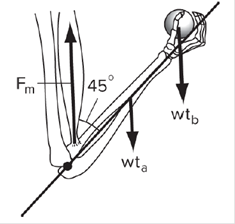
Concept explainers
A 35-N hand and forearm are held at a 45° angle to the vertically oriented humerus. The CG of the forearm and hand is located at a distance of 15 cm from the joint center at the elbow, and the elbow flexor muscles attach at an average distance of 3 cm from the joint center. (Assume that the muscles attach at an angle of 45° to the bones.)
a. How much force must be exerted by the forearm flexors to maintain this position?
b. How much force must the forearm flexors exert if a 50-N weight is held in the hand at a distance along the arm of 25 cm? (Answers: a. 175 N; b. 591.7 N)

a)
To determine: The force exerted by the forearm.
Answer to Problem 3AP
The force exerted by the forearm is
Explanation of Solution
Calculation:
Consider torque acts on the counter clockwise direction for forearm of the hand will be taken as positive and the torque acts on the clockwise direction for joint center of the elbow will be taken as negative.
Express the magnitude of the net torque acts on the joints.
Here,
Rewrite the equation (I) for the net forces acts on the joints of the hand.
Here,
Substitute
Therefore, the force exerted by the forearm is
b)
To determine: The force on the forearm flexors exerts on the weight hold in the hand.
Answer to Problem 3AP
The force on the forearm flexors exerts on the weight hold in the hand is
Explanation of Solution
Calculation:
Rewrite the equation (I) for the net forces acts on the weight holds in the hand.
Here,
Substitute
Solve the relation for
Therefore, the force on the forearm flexors exerts on the weight hold in the hand is
Want to see more full solutions like this?
Chapter 13 Solutions
Gen Combo Ll Basic Biomechanics; Connect Ac; Maxtraq Software Ac
- Movement at the shoulder joint that moves the upper limb laterally away from the body is called ________. elevation eversion abduction lateral rotationarrow_forwardA/An ____________________________ injury can be a strain or tear on any of the three muscles that straighten the hip and bend the knee. Achilles tendon hamstring myofascial shin splintarrow_forwardInflamed and swollen tendons caught in the narrow space between the bones within the shoulder joint cause the condition known as ____________________. impingement syndrome intermittent claudicationarrow_forward
 Human Physiology: From Cells to Systems (MindTap ...BiologyISBN:9781285866932Author:Lauralee SherwoodPublisher:Cengage Learning
Human Physiology: From Cells to Systems (MindTap ...BiologyISBN:9781285866932Author:Lauralee SherwoodPublisher:Cengage Learning Fundamentals of Sectional Anatomy: An Imaging App...BiologyISBN:9781133960867Author:Denise L. LazoPublisher:Cengage LearningLifetime Physical Fitness & WellnessHealth & NutritionISBN:9781337677509Author:HOEGERPublisher:Cengage
Fundamentals of Sectional Anatomy: An Imaging App...BiologyISBN:9781133960867Author:Denise L. LazoPublisher:Cengage LearningLifetime Physical Fitness & WellnessHealth & NutritionISBN:9781337677509Author:HOEGERPublisher:Cengage Medical Terminology for Health Professions, Spira...Health & NutritionISBN:9781305634350Author:Ann Ehrlich, Carol L. Schroeder, Laura Ehrlich, Katrina A. SchroederPublisher:Cengage Learning
Medical Terminology for Health Professions, Spira...Health & NutritionISBN:9781305634350Author:Ann Ehrlich, Carol L. Schroeder, Laura Ehrlich, Katrina A. SchroederPublisher:Cengage Learning Anatomy & PhysiologyBiologyISBN:9781938168130Author:Kelly A. Young, James A. Wise, Peter DeSaix, Dean H. Kruse, Brandon Poe, Eddie Johnson, Jody E. Johnson, Oksana Korol, J. Gordon Betts, Mark WomblePublisher:OpenStax College
Anatomy & PhysiologyBiologyISBN:9781938168130Author:Kelly A. Young, James A. Wise, Peter DeSaix, Dean H. Kruse, Brandon Poe, Eddie Johnson, Jody E. Johnson, Oksana Korol, J. Gordon Betts, Mark WomblePublisher:OpenStax College





